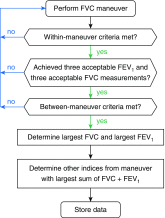Standardization of Spirometry 2019 Update. An Official American Thoracic Society and European Respiratory Society Technical Statement
- PMID: 31613151
- PMCID: PMC6794117
- DOI: 10.1164/rccm.201908-1590ST
Standardization of Spirometry 2019 Update. An Official American Thoracic Society and European Respiratory Society Technical Statement
Abstract
Background: Spirometry is the most common pulmonary function test. It is widely used in the assessment of lung function to provide objective information used in the diagnosis of lung diseases and monitoring lung health. In 2005, the American Thoracic Society and the European Respiratory Society jointly adopted technical standards for conducting spirometry. Improvements in instrumentation and computational capabilities, together with new research studies and enhanced quality assurance approaches, have led to the need to update the 2005 technical standards for spirometry to take full advantage of current technical capabilities.Methods: This spirometry technical standards document was developed by an international joint task force, appointed by the American Thoracic Society and the European Respiratory Society, with expertise in conducting and analyzing pulmonary function tests, laboratory quality assurance, and developing international standards. A comprehensive review of published evidence was performed. A patient survey was developed to capture patients' experiences.Results: Revisions to the 2005 technical standards for spirometry were made, including the addition of factors that were not previously considered. Evidence to support the revisions was cited when applicable. The experience and expertise of task force members were used to develop recommended best practices.Conclusions: Standards and consensus recommendations are presented for manufacturers, clinicians, operators, and researchers with the aims of increasing the accuracy, precision, and quality of spirometric measurements and improving the patient experience. A comprehensive guide to aid in the implementation of these standards was developed as an online supplement.
Keywords: pulmonary function; spirometer; spirometry; technical standards.
Figures




Comment in
-
Reply to Arce: On the 2019 Spirometry Statement.Am J Respir Crit Care Med. 2020 Mar 1;201(5):627. doi: 10.1164/rccm.201911-2161LE. Am J Respir Crit Care Med. 2020. PMID: 31743652 Free PMC article. No abstract available.
-
On the 2019 Spirometry Statement.Am J Respir Crit Care Med. 2020 Mar 1;201(5):626-627. doi: 10.1164/rccm.201910-2076LE. Am J Respir Crit Care Med. 2020. PMID: 31743653 Free PMC article. No abstract available.
-
The American Thoracic Society/European Respiratory Society 2019 Spirometry Statement and Occupational Spirometry Testing in the United States.Am J Respir Crit Care Med. 2020 Apr 15;201(8):1010-1011. doi: 10.1164/rccm.201911-2267LE. Am J Respir Crit Care Med. 2020. PMID: 31930925 Free PMC article. No abstract available.
-
Reply to Townsend: The American Thoracic Society/European Respiratory Society 2019 Spirometry Statement and Occupational Spirometry Testing in the United States.Am J Respir Crit Care Med. 2020 Apr 15;201(8):1012. doi: 10.1164/rccm.201912-2530LE. Am J Respir Crit Care Med. 2020. PMID: 31930926 Free PMC article. No abstract available.
-
Calibration Myths in the 2019 American Thoracic Society/European Respiratory Society Spirometry Technical Standards.Am J Respir Crit Care Med. 2020 Jul 15;202(2):303-304. doi: 10.1164/rccm.202003-0658LE. Am J Respir Crit Care Med. 2020. PMID: 32271612 Free PMC article. No abstract available.
-
Reply to Haynes et al.: Calibration Myths in the 2019American Thoracic Society/European Respiratory Society Spirometry Technical Standards.Am J Respir Crit Care Med. 2020 Jul 15;202(2):304. doi: 10.1164/rccm.202003-0728LE. Am J Respir Crit Care Med. 2020. PMID: 32271614 Free PMC article. No abstract available.
References
-
- Miller MR, Hankinson J, Brusasco V, Burgos F, Casaburi R, Coates A, et al. ATS/ERS Task Force. Standardisation of spirometry. Eur Respir J. 2005;26:319–338. - PubMed
-
- American Thoracic Society. ATS statement: snowbird workshop on standardization of spirometry. Am Rev Respir Dis. 1979;119:831–838. - PubMed
-
- Statement of the American Thoracic Society. Standardization of spirometry: 1987 update. Am Rev Respir Dis. 1987;136:1285–1298. - PubMed
-
- American Thoracic Society. Standardization of spirometry, 1994 update. Am J Respir Crit Care Med. 1995;152:1107–1136. - PubMed
-
- Quanjer PH. Standardized lung function testing: report working party standardization of lung function tests. Bull Eur Physiopathol Respir. 1983;19(Suppl 5):1–95. - PubMed
Publication types
MeSH terms
LinkOut - more resources
Full Text Sources
Other Literature Sources
Medical

